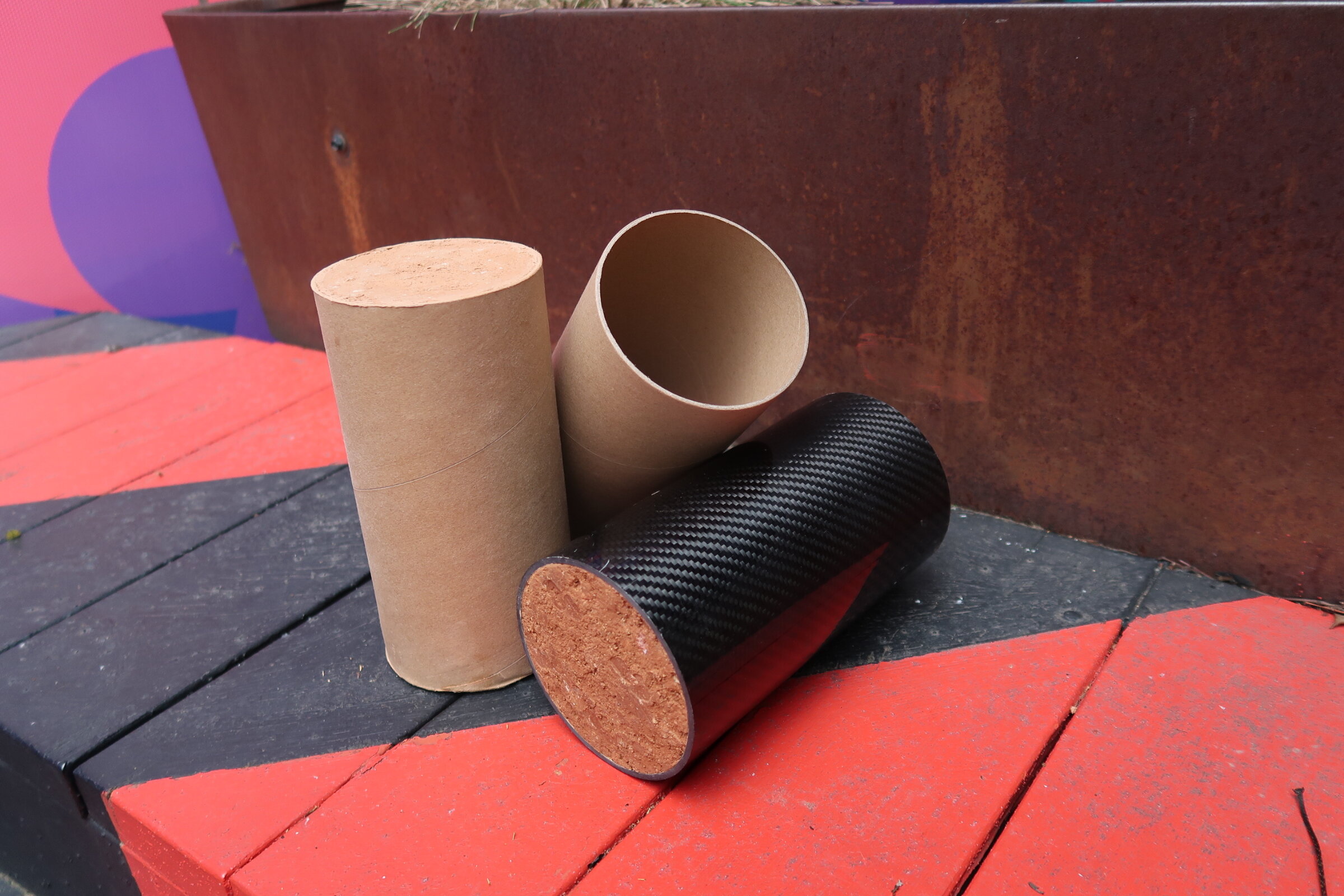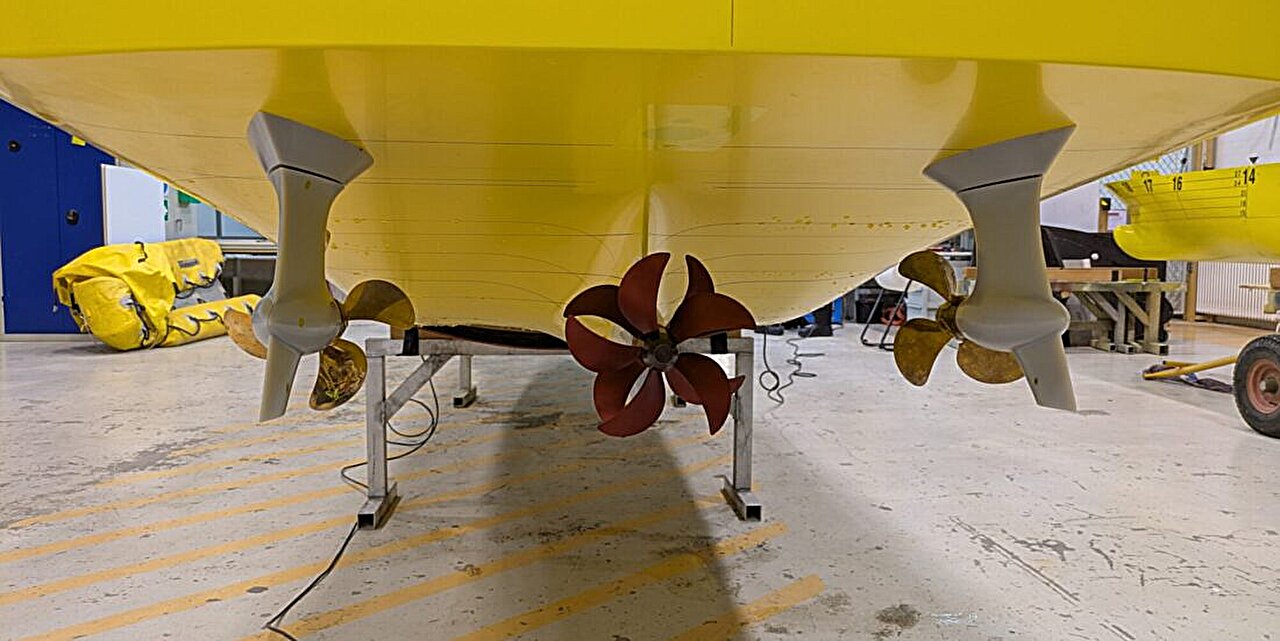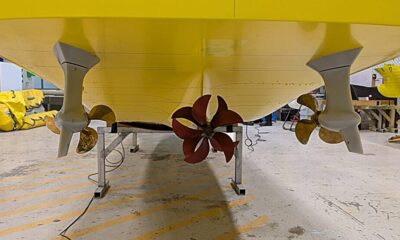Tech
Cardboard and earth combine to create low-carbon alternative to concrete

Engineers in Australia have developed a new building material with about one quarter of concrete’s carbon footprint, while reducing waste going to landfill. The research is published in the journal Structures.
This innovative material, called cardboard-confined rammed earth, is composed entirely of cardboard, water and soil—making it reusable and recyclable.
In Australia alone, more than 2.2 million tons of cardboard and paper are sent to landfill each year. Meanwhile, cement and concrete production account for about 8% of annual global emissions.
Cardboard has previously been used in temporary structures and disaster shelters, such as Shigeru Ban’s iconic Cardboard Cathedral in Christchurch, New Zealand.
Inspired by such designs, the RMIT University team has, for the first time, combined the durability of rammed earth with the versatility of cardboard.
Lead author Dr. Jiaming Ma from RMIT said the development of cardboard-confined rammed earth marked a significant advancement toward a more sustainable construction industry.
“Modern rammed earth construction compacts soil with added cement for strength. Cement use is excessive given the natural thickness of rammed earth walls,” he said.
But cardboard-confined rammed earth, developed at RMIT University, eliminates the need for cement and boasts one quarter of the carbon footprint at under one third of the cost, compared to concrete.
“By simply using cardboard, soil and water, we can make walls robust enough to support low-rise buildings,” Ma said.
“This innovation could revolutionize building design and construction, using locally sourced materials that are easier to recycle.
“It also reflects the global revival of earth-based construction fueled by net zero goals and interest in local sustainable materials.”
-

Image of study lead author Dr. Jiaming Ma holding the cardboard-confined rammed earth material. Credit: RMIT University
-

The RMIT-based research team. L–R: Hongru Zhang, Jiaming Ma, Dilan Robert and Ngoc San Ha. Credit: RMIT University
Practical benefits
The cardboard-confined rammed earth can be made on the construction site by compacting the soil and water mixture inside the cardboard formwork, either manually or with machines.
Study corresponding author and leading expert in the field of structural optimization, Emeritus Professor Yi Min “Mike’ Xie, said this advancement can spearhead a leaner, greener approach to construction.
“Instead of hauling in tons of bricks, steel and concrete, builders would only need to bring lightweight cardboard, as nearly all material can be obtained on site,” Xie said.
“This would significantly cut transport costs, simplify logistics and reduce upfront material demands.”
Ma said cardboard-confined rammed earth could be an effective solution for construction in remote areas, such as regional Australia, where red soils—ideal for rammed earth construction—are plentiful.
“Rammed earth buildings are ideal in hot climates because their high thermal mass naturally regulates indoor temperatures and humidity, reducing the need for mechanical cooling and cutting carbon emissions,” he said.
The mechanical strength of the novel material varies based on the thickness of the cardboard tubes.
Ma said the team has developed the formula for this strength design.
“We’ve created a way to figure out how the thickness of the cardboard affects the strength of the rammed earth, allowing us to measure strength based on cardboard thickness,” Ma said.
-

An RMIT-created cardboard-confined rammed earth column. Credit: RMIT University
-

An RMIT-created cardboard-confined rammed earth column. Credit: RMIT University
In a separate study led by Ma and published in Composite Structures, carbon fiber was combined with rammed earth, proving it had a comparable strength to high-performance concrete.
Ma and the team are ready to partner with various industries to further develop this new material so it can be used widely.
More information:
Jiaming Ma et al, Cardboard-confined rammed earth towards sustainable construction, Structures (2025). DOI: 10.1016/j.istruc.2025.110117
Jiaming Ma et al, CFRP-confined rammed earth towards high-performance earth construction, Composite Structures (2025). DOI: 10.1016/j.compstruct.2025.119512
Citation:
Cardboard and earth combine to create low-carbon alternative to concrete (2025, September 22)
retrieved 22 September 2025
from https://techxplore.com/news/2025-09-cardboard-earth-combine-carbon-alternative.html
This document is subject to copyright. Apart from any fair dealing for the purpose of private study or research, no
part may be reproduced without the written permission. The content is provided for information purposes only.
Tech
This is how two contra-rotating propellers can make ships more energy efficient

By using two propellers that rotate in opposite directions, a ship can use less energy to move forward. New knowledge means that more ships can use the technology, including Hurtigruten’s Sea Zero project for its coastal cruise ships.
SINTEF has now designed and manufactured new measuring equipment for model testing of contra-rotating propellers. This could be good news for many large ships.
“We see that propulsion efficiency increases when we utilize some of the energy lost from the front propeller at the same time as the rear propeller gets better water flow. This can provide more than 10% better efficiency compared to conventional propellers,” says Øyvind Rabliås, a researcher at SINTEF.
Although contra-rotating propellers are not new, they are still rarely used on commercial ships. The reason has been their cost and more complicated design than traditional layouts. That may be changing now.
“Together with our research partners, we’ve spent a lot of time on understanding and developing solutions for this. Now we believe that the technology is mature and ready for wider use,” says Jahn Terje Johannessen. He is a senior hydrodynamicist at Brunvoll, a leading provider of propulsion and maneuvering systems.
Good test results
SINTEF’s new measurement system was developed when Hurtigruten decided to use contra-rotating propellers for its zero-emission cruise ship in the Sea Zero project. The goal is an emission-free Hurtigruten ship with a sustainable and circular solution by 2030.
Contra-rotating propellers have significantly better efficiency than today’s propeller systems.
“This design simply means that we need less energy to achieve the same speed compared to conventional propellers. Brunvoll’s design is also more efficient than the contra-rotating propellers that exist today,” says Gerry Larsson-Fedde, chief operating officer at Hurtigruten.
From drawing board to reality
A broad interdisciplinary team at SINTEF Ocean, from technicians and instrumentation engineers to design experts and researchers, has developed the new measuring equipment for model testing contra-rotating propellers. Together, they arrived at a solution that is well suited for self-propulsion tests.
Two dynamometers, which are instruments used to measure force in rotating systems, have also been developed.
“One version is suitable for integrating into ship models that are tested in the Towing Tank, meaning that it is built into the model, and the other version is used in open water tests and in cavitation tests,” says Rabliås.
The system has already tested Brunvoll’s propeller system for Hurtigruten. The results provided valuable insight into the system’s performance and helped identify the most efficient propulsion solution for further development.
“It was an added bonus for Brunvoll that the project is so versatile. We have a lot of different industrially relevant issues in our work to create a demonstrator,” says Johannessen.

Hurtigruten is also very pleased to have its ground-breaking ship tested.
“It’s fantastic for us that we can test all the parts of the Sea Zero design at such a professional and advanced laboratory as SINTEF has. Contra-rotating propellers are new to us, and they are not common on ships either. That’s why it is so important for us to be able to thoroughly test the ship design in the cavitation tunnel. Then we’ll know that it will work in practice,” says Larsson-Fedde.
Some challenges too
Propulsion efficiency is increased by recovering part of the energy loss from the front propeller and by better inflow to the rear propeller. That is why it is possible to achieve more than a 10% increase compared to conventional propellers. However, contra-rotating propellers require a complex shaft-in-shaft system.
“The design process is also more complicated than for conventional propellers, both because of complex flow phenomena and the larger number of parameters that need to be adjusted, compared to one propeller. This applies to both the diameter ratio and the propeller’s revolution ratio between the two propellers, for example,” says Rabliås.
It will be exciting to follow the developments in the future for Hurtigruten as well.
“The goal of Sea Zero is to design the world’s most energy-efficient ship, and in that quest we have to leave no stone unturned. The propulsion itself uses a lot of energy, and so contra-rotating propellers are very exciting for us to look at,” says Larsson-Fedde.
Citation:
This is how two contra-rotating propellers can make ships more energy efficient (2025, November 10)
retrieved 10 November 2025
from https://techxplore.com/news/2025-11-contra-rotating-propellers-ships-energy.html
This document is subject to copyright. Apart from any fair dealing for the purpose of private study or research, no
part may be reproduced without the written permission. The content is provided for information purposes only.
Tech
Sweat-powered sticker turns your drinking cup into a health sensor

A team of engineers at the University of California San Diego has developed an electronic sticker that can monitor a person’s vitamin C levels using the sweat from their fingertips—no blood draws, lab visits or batteries required. The flexible sticker, which attaches to the outside of a drinking cup, collects trace amounts of sweat as a person grips the cup. Within minutes, the system harvests enough power from the sweat to analyze it for vitamin C and wirelessly sends the results to a nearby laptop.
Details about the device are published in Biosensors and Bioelectronics.
“By turning everyday objects like cups or bottles into smart sensors, people can gain real-time insights into their health and wellness without changing a thing about their daily routine,” said study co-senior author Patrick Mercier, a professor in the Department of Electrical and Computer Engineering at the UC San Diego Jacobs School of Engineering.
“We’re moving toward a future of ‘unawareables’—devices that are unobtrusive and essentially invisible so that you are unaware that you’re even using them. You just go about your day and your drinking cup can give you access to all this rich information.”
Malnutrition and micronutrient deficiencies continue to affect millions of people worldwide. While vitamin C plays a key role in immune function, tissue repair and iron absorption, testing for it currently requires blood draws, specialized laboratory equipment and costs around $50 per test in the U.S. These barriers make frequent monitoring impractical for many people.

The new sticker offers a simple, convenient and low-cost alternative. Built on a flexible, adhesive polymer sheet, the system integrates screen-printed electronic components. A porous hydrogel pad mounted on the sticker collects sweat from the fingertips. A built-in biofuel cell converts chemicals in the sweat into electricity, which powers a custom printed circuit board and the vitamin C sensor. The circuit board reads signals from the vitamin C sensor and wirelessly transmits the data via Bluetooth low energy.
“Most people only get a snapshot of their health once a year at the doctor. But our bodies change much more frequently than that,” Mercier said. “We want to make access to health data as frequent and effortless as holding your morning coffee cup or orange juice bottle.”
Another special feature of the sticker is that it generates power without requiring physical exertion from the user. Fingertips, despite their small size, are among the body’s most prolific sweat producers—each is packed with over a thousand sweat glands and can produce between 100 and 1,000 times more sweat than most other areas on the body. This steady trickle of natural perspiration provides a continuous energy source that allows the sticker to operate even when the user is at rest.
Because the system is battery-free, it can be manufactured at low cost—potentially for just a few cents per unit. Its affordability could also make future versions of the system disposable and widely accessible, particularly in low-resource areas.
-

Study co-first author Muhammad Inam Khan, a nano engineering Ph.D. student at the UC San Diego Jacobs School of Engineering, demonstrates fingertip placement on the sticker while gripping a boba drink. Three fingertips rest on the arched biofuel cell (left) while the tip of the middle finger rests on the vitamin C sensor (right). Credit: David Baillot/UC San Diego Jacobs School of Engineering
-

Study co-first author Ryan Burns, an electrical and computer engineering Ph.D. student at the UC San Diego Jacobs School of Engineering, uses the sticker on a cup filled with orange juice. Credit: David Baillot/UC San Diego Jacobs School of Engineering
The work is a collaboration between the labs of Mercier and Joseph Wang, a professor in the Aiiso Yufeng Li Family Department of Chemical and Nano Engineering at the UC San Diego Jacobs School of Engineering. It builds on wearable technologies that Wang’s lab has pioneered—including tattoo-like biochemical sensors and fingertip-power wearables—along with ultra-low power, battery-free wireless systems developed in Mercier’s lab.
In tests, the device was stuck onto a disposable drinking cup and accurately tracked changes in vitamin C levels after participants took a supplement or drank orange juice. The device powered itself for more than two hours using only sweat-derived energy.
“This is an elegant extension of our early fingertip sweat-based technology toward effortless, continuous monitoring of personal nutrition and health,” said Wang, one of the study’s co-senior authors. “By moving sensors from the skin to the surface of everyday objects like cups or bottles, we are expanding what wearable technology can be.”
The team plans to expand the technology to measure additional nutrients and biochemicals. Future versions could send readings directly to smartphones or smartwatches to provide more seamless, real-time tracking of personal health data throughout the day.
Co-authors of the study include Muhammad Inam Khan, Ryan Burns, Akshit Agarwal, Lu Yin, Jongmin Moon, Bumsik Choi, Shichao Ding and Tamoghna Saha, all at UC San Diego.
More information:
Muhammad Inam Khan et al, A smart cup for wireless, biofuel-powered, sweat-based vitamin C sensing, Biosensors and Bioelectronics (2026). DOI: 10.1016/j.bios.2025.118100
Citation:
Sweat-powered sticker turns your drinking cup into a health sensor (2025, November 10)
retrieved 10 November 2025
from https://techxplore.com/news/2025-11-powered-sticker-cup-health-sensor.html
This document is subject to copyright. Apart from any fair dealing for the purpose of private study or research, no
part may be reproduced without the written permission. The content is provided for information purposes only.
Tech
From waste to asset: Turning ethanol production CO₂ into jet fuel

Manufacturing sustainable aviation fuel with CO₂ byproducts of ethanol production could reduce carbon intensity by more than 80% compared to fossil fuels.
The CO2 released from corn during ethanol production could actually be a valuable, underutilized resource for producing aviation fuel rather than a waste byproduct, according to a study published in the SAE International Journal of Sustainable Transportation, Energy, Environment, & Policy.
Unlike the CO₂ from coal plants or cement kilns, which requires a lot of energy to capture, fermentation to produce ethanol releases very pure streams containing 85% CO₂ by volume or higher. As the corn plants sequestered CO₂ from the air, capturing the CO₂ released from fermentation and using it as fuel would reuse CO₂ without adding more to the atmosphere.
“It is exciting to explore whether this ‘waste’ stream can actually become a significant asset, turning inefficiency into advantage and accelerating the real-world application of emerging technologies,” said Stephen McCord, a research scientist in mechanical engineering at U-M and lead author of the study.
With aviation producing over a gigaton of fossil CO2 emissions annually, sustainable aviation fuel produced from non-fossil carbon stocks can help reduce these emissions. Often made from biomass waste or cooking oils, small percentages of sustainable aviation fuels are already blended with conventional kerosene fuels, with the aviation industry and travelers pushing towards larger integration.
The United States produced 15.6 billion gallons of ethanol in 2023, releasing 48 megatons of CO₂, offering a route to produce sustainable aviation fuel at scale. With several different ways to make sustainable aviation fuel from bioethanol, the research team compared pathways to determine the ones with the lowest environmental impact.
“We hope to inform future development and policy by highlighting which routes are most promising for reducing aviation’s carbon footprint using existing waste resources,” said Volker Sick, former Director of the Global CO₂ Initiative and the DTE Energy Professor of Advanced Energy Research at U-M and senior author of the study.
The current corn-based sustainable aviation fuel production method chemically modifies ethanol to make aviation fuel through a process called Alcohol-to-Jet. Although it has a high fuel yield of 90%, this route only reduces carbon intensity by about 4.5% to 20% compared to kerosene jet fuel.
The research team compared this method to two CO₂-based routes. Both methods begin by converting captured CO₂ into syngas, a mixture of carbon monoxide (CO) and hydrogen gas (H₂). The gas fermentation route uses syngas to create ethanol as an intermediate step, then uses Alcohol-to-Jet to produce fuel. The Fischer-Tropsch Synthesis route instead feeds syngas into a reactor, synthesizing the long-chain liquid hydrocarbons that make up jet fuel.
A life cycle assessment found both approaches outperformed conventional methods, with Fischer-Tropsch Synthesis projected to reduce carbon intensity by up to 90% while gas fermentation was projected to reduce it by 84%.
When considering existing bioethanol facilities and workforce skills, gas fermentation followed by Alcohol-to-Jet came out on top as the path with the smoothest transition despite a slightly lower carbon intensity reduction.
“A variety of factors need to be considered when planning how to produce large quantities of sustainable aviation fuels from CO₂. Starting with CO₂ from corn ethanol fermentation promises the fastest path to scaling up this new industry,” said Sick.
As a follow-up, the research team assessed the economic competitiveness of these two pathways to understand which would operate best in real-world conditions and which could be deployed quickest in the US.
With electrification and hydrogen both facing significant technical and practical obstacles for long-distance air travel, hydrocarbon fuels will likely remain essential for aviation in the foreseeable future.
“These conversion routes provide a viable way to ‘defossilize’ aviation fuel and make meaningful progress towards reducing aviation’s carbon footprint—offering a realistic, near-term solution where alternatives are limited,” said McCord.
More information:
Stephen McCord et al, A Life Cycle Assessment of Potential Pathways to Increase SustainableAviation Fuel Yields through CO2 Upgrading Co-located with CornEthanol Production, SAE International Journal of Sustainable Transportation, Energy, Environment, & Policy (2025). DOI: 10.4271/13-06-03-0023
Citation:
From waste to asset: Turning ethanol production CO₂ into jet fuel (2025, November 10)
retrieved 10 November 2025
from https://techxplore.com/news/2025-11-asset-ethanol-production-jet-fuel.html
This document is subject to copyright. Apart from any fair dealing for the purpose of private study or research, no
part may be reproduced without the written permission. The content is provided for information purposes only.
-

 Politics1 week ago
Politics1 week agoPolitical violence kills almost 300 since Hasina’s fall: rights group
-

 Sports1 week ago
Sports1 week agoPakistani runners make their mark at Istanbul Marathon
-

 Politics1 week ago
Politics1 week agoIran vows to rebuild nuclear sites ‘stronger than before’
-

 Tech1 week ago
Tech1 week agoLive TV Isn’t Dead. These Are the Best Live TV Streaming Services
-

 Entertainment1 week ago
Entertainment1 week agoPresident Zardari to attend Second World Summit for Social Development in Doha
-

 Sports1 week ago
Sports1 week agoDyche fumes at Man Utd goal, calls for VAR change
-

 Entertainment1 week ago
Entertainment1 week agoGeorge Clooney on “Jay Kelly,” fame and family
-

 Tech1 week ago
Tech1 week agoCISOs in court: Balancing cyber resilience and legal accountability | Computer Weekly


















